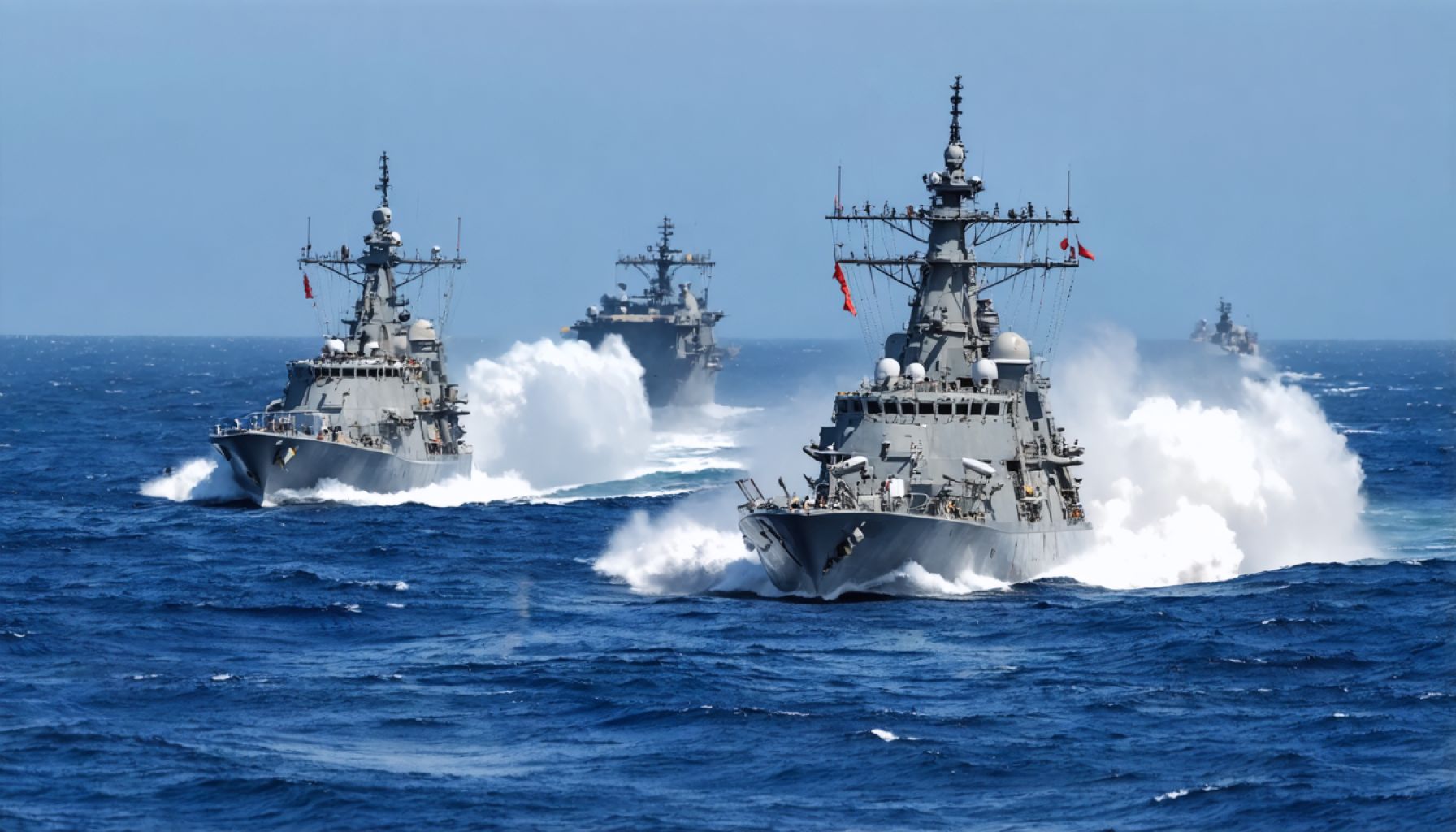- Chinese navy conducted a live-fire exercise on the Tasman Sea, raising concerns in the Pacific region.
- The exercise was observed by New Zealand’s frigate Te Kaha, highlighting regional vigilance and unease.
- Airlines had to reroute flights to ensure aviation safety, demonstrating the drill’s widespread impact.
- Chinese officials asserted that their exercises complied with international law, downplaying neighboring countries’ concerns.
- New Zealand’s Prime Minister Luxon stressed the importance of caution and monitoring the Chinese flotilla.
- This event underscores ongoing regional tensions and the significance of naval strength in international relations.
- The exercise highlights the importance of vigilance and preparation in navigating complex maritime dynamics.
A symphony of steel and fire played out on the vast, rolling waters of the Tasman Sea, as the Chinese navy executed a dramatic live-fire exercise, sparking unease across the Pacific region. The rhythmic boom of the vessel’s main gun shattered the tranquil air, witnessed keenly by sailors aboard New Zealand’s frigate Te Kaha, who monitored the drill with a wary vigilance.
This bold display of military might unfurled against the backdrop of a serene ocean, mere hours after airlines scrambled to reroute their planes to avoid the perilous path of a Chinese naval announcement. Skies above the sea buzzed with redirected flights, illustrating the sweeping impact of these complex international waters on aviation safety. Despite the initial disruption, Chinese officials maintained their drills adhered to the sanctity of international law, dismissing objections from neighboring nations as overblown, a narrative that entwines diplomacy with maritime dominance.
Prime Minister Christopher Luxon emphasized New Zealand’s need for caution and watchfulness, noting the ambiguous intentions of the Chinese flotilla. Yet, beyond the horizon, questions loomed – where would these ships glide next, and what message did they seek to convey through their formidable display of firepower?
By harnessing the world’s most remote waters as a stage for their exercises, China illuminated an ongoing narrative of regional tension and the precarious balance of international relations. In a world where power is both a symbol and a currency, these drills are stark reminders of geopolitical realities where naval prowess plays a key role. The takeaway echoes through the annals of policy and power: vigilance and preparation remain paramount as nations navigate these complex maritime dynamics.
China’s Naval Drills: Unveiling the Waves of Geopolitical Tension and Strategic Navigation
How-To Steps & Life Hacks for Monitoring Naval Exercises
1. Utilize AIS Tracking Systems: Automatic Identification Systems (AIS) are crucial for tracking maritime activity. Platforms like MarineTraffic allow users to monitor real-time movements of naval vessels, including their paths and destinations.
2. Leverage Open Source Intelligence (OSINT): Gather information from public domain sources, such as news outlets, social media, and government announcements. Tools like Google Alerts can help stay updated on naval activities.
3. Engage with Regional Defense Analysts: Experts in maritime security provide insights and analyses on exercises. Following their assessments can offer valuable perspectives.
Real-World Use Cases of Naval Drills
– Diplomatic Signaling: These exercises serve as a strategic communication method. They signal military capabilities and intentions, impacting diplomatic negotiations and influencing geopolitical partnerships.
– Operational Readiness: Drills ensure that naval forces maintain high readiness levels to respond to potential threats, conduct humanitarian missions, and enforce maritime law.
Market Forecasts & Industry Trends
The global naval market is expected to grow significantly, with increased investments in advanced naval technology and shipbuilding. According to Forecast International, the naval market could see annual growth rates exceeding 4% over the next decade.
Reviews & Comparisons
– Effectiveness of Naval Drills: These drills are compared based on scale, frequency, and the advanced nature of equipment and tactics used. The PLAN (People’s Liberation Army Navy) is often reviewed in the context of U.S. Navy and Royal Navy exercises.
– Technological Advancements: The integration of AI and drone technologies is revolutionizing naval drills, offering increased precision and data collection capabilities.
Controversies & Limitations
– Legal and Ethical Considerations: The legality of conducting drills in international waters versus disputed maritime territories often sparks international debate. Neighboring countries express concerns over perceived territorial aggression.
– Environmental Impact: Live-fire exercises can have adverse effects on marine ecosystems, raising sustainability issues.
Features, Specs & Pricing of Naval Equipment
The PLAN’s vessels are equipped with state-of-the-art technologies, including hypersonic missiles and advanced radar systems. The cost of maintaining this fleet is substantial, with each vessel’s construction reaching hundreds of millions of dollars.
Security & Sustainability
Security is reinforced by enhancing maritime awareness and anti-access/area-denial (A2/AD) capabilities. Sustainability challenges are addressed through international cooperation on environmental standards for naval operations.
Insights & Predictions
– Increasing Maritime Tensions: As naval powers like China expand their maritime presence, tensions in regions like the South China Sea and Pacific Ocean are likely to heighten.
– Focus on Unmanned Vessels: Unmanned surface and underwater vehicles are predicted to play greater roles in future naval operations.
Tutorials & Compatibility
Tutorials on interpreting naval data from platforms like AIS and OSINT sources can be found through online courses and maritime defense workshops.
Pros & Cons Overview
Pros:
– Enhances national defense capabilities.
– Promotes technological advancements in maritime industries.
– Facilitates multinational cooperation through joint exercises.
Cons:
– Can escalate regional tensions and provoke political conflicts.
– Potential environmental harm to marine life.
– High costs associated with advanced military technology.
Actionable Recommendations
– Stay Informed: Regularly monitor international maritime news from reliable sources like Reuters or BBC.
– Engage in Diplomatic Dialogues: Advocate for transparent communication between nations to alleviate misunderstandings related to military exercises.
– Balance Deterrence with Diplomacy: Countries should maintain a strong defense posture while actively pursuing diplomatic solutions to conflicts.
By incorporating these insights, individuals and policymakers can better navigate the intricate world of international naval dynamics and prepare for future geopolitical shifts.








